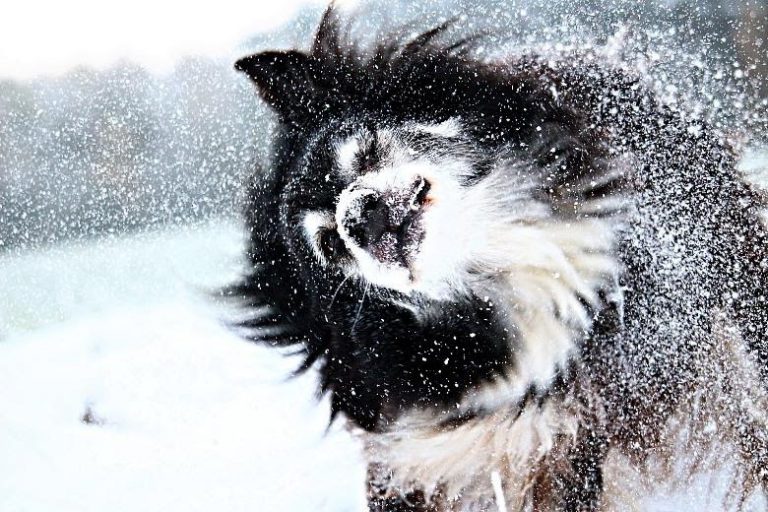By Cynthia Garcia (guest author)
The winter months are synonymous with shying away from the outdoors and cozying up near the fireplace with our pets. In fact, studies have confirmed that human beings and their pets tend to add weight in winter. And with the days being colder and shorter, taking long walks with our dogs is not as appealing as in spring and summer.
Instead of hibernating indoors and allowing your pet to gain weight, why don’t you look for creative solutions to help him burn the extra energy? After all, struggling with your dog to lose the extra weight in spring is way harder than preventing winter weight gain. So here are a few tips to help keep your dog healthy and fit during the winter months.


Image by rihaij from Pixabay
- Get Your Dog’s Pre-Winter Health Report
Before the cold winter months start, make sure you take your dog to the vet and get a pre-winter cold report. You can also ask the vet if your dog has any health issues that can predispose him to gain weight. The vet can help you set some health goals for your pet and recommend some winter workouts routines. - Adjust Your Furry Pal’s Diet to His Seasonal Needs
The cold winter months bring new challenges and changes that each pooch must face. So unless your dog stays active he probably won’t require more calories. So make sure you adjust your dog’s calorie intake with his winter activity level and current weight. - Monitor Your Dog’s Weight and Make Adjustments When Necessary
Before the winter starts, you can find out your dog’s weight and then monitor any fluctuation during the winter months. Knowing your dog’s current condition can help you set weight goals for your dog and develop ways to prevent weight gain. Tracking your dog’s progress can show you if your workout and eating schedule is working and when to make adjustments. - Create a weight loss plan
Since your dog is at risk of gaining some weight during winter, you should sit down with your vet and create a unique weight loss plan that will help him maintain his current weight. This plan could include workout routines and dietary changes. The workout routines will ensure he stays active during the winter months. And if he was already overweight, you will have to work even harder to prevent him from adding more weight and even help him drop some calories in the process. - Use the Treats Sparingly
Most vets recommend that you stop giving your dog treats during winter, especially if your pooch is overweight. But if your vet believes that treats will not affect your winter dietary plan, then you should continue giving your pet treats sparingly. You can use healthy treats to entice him to start working out and burn the extra energy. You can use healthy treats for a short period until he gets used to working out without food-based rewards. - Support Their Joints
The cold, dry winter weather can do a lot on a dog’s joints. If your dog is prone to hip dysplasia or arthritis, then the cold weather can worsen his situation. And this will prevent him from working out, and he might end up gaining winter weight in the process. So, try and add some dietary supplements to your older pup’s diet. Omega fatty acids, chondroitin, and glucosamine are great for your dog’s joints. So look for food containing these ingredients or add a dietary supplement to his diet. - Adjust Your Dog’s Workout Routine
Instead of canceling your dog’s walks in winter, you can try and adjust his routines. Take frequent short walks around the neighborhood with your dog during the day. Regular walks can keep your pet from getting cold, reduce their separation anxiety and also give him the needed workout. - Introduce Your Dog to Numerous Backyard Activities
If your dog can tolerate the snow, you can include him in all the numerous family backyard activities like sledding, building snowmen, and fetching. After all, if the entire family is outside playing, then your dog will also be enticed to get out and join in the fun…
- Teach Him Some New Indoor Games
If your dog dislikes snow, you can develop numerous indoor games to help him exercise. You can play fetch or hide-n-seek, or tug-of-war. - Practice Your Training
Instead of giving in and cuddling on the couch the whole season with your dog, you can keep him active by practicing some new tricks. Remember, keeping him active will help prevent weight gain, and thinking can also be as tiring as running or walking outside. If your pooch has mastered stay, sit, and down, you can try and mix these commands with a game like “find it” or “fetch.” You can also try a dog push-up by asking your pooch to lay down, sit, and lay down again several times for a healthy treat. - Get Him a Dog Treadmill
Since your dog is at risk of gaining weight in winter, you can get your dog a treadmill, which he will be using to exercise when running outside is impossible. Start slowly and increase the pace as he gets more and more comfortable with the treadmill. A dog treadmill is a great workout.
Final Thoughts
Being sedentary during the cold winter months can result in both you and your pet gaining some winter weight. And since helping him lose weight in spring is harder than making sure he doesn’t gain weight in the first place, you can try and keep him active. You can also reduce his calorie intake and also teach him some new indoor exercises. Remember, keeping him healthy and active should be your primary goal in winter.
Cynthia Garcia is the editor and content creator at the Crazy Pet Guy. She’s a passionate pet rescue supporter and in her free time, she’s always looking for ways to help the community.

